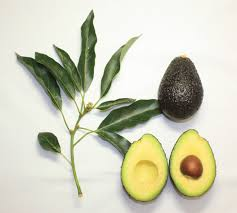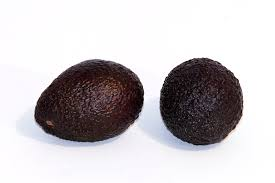Hass Avocado
 Common Names: Aguacate Hass, āhuacatl (nahuatl), palta (from the Quechua language language and commonly used in South America)
Common Names: Aguacate Hass, āhuacatl (nahuatl), palta (from the Quechua language language and commonly used in South America)
Scientific Name: Persea americana
Climate: Hot and warm
Plant Description: Hass avocado is a deciduous tree that reaches up to 20 meters high. The trunk of greyish-brown bark is straight and measures between 30 and 60 centimetres in diameter. The leaves are alternate, bright green in color in the upper region and of a lighter tone in the lower one. They are oval, with a pointed end. They are 12 to 25 centimeters long.
Its flowers are small and show a greenish color in its six petals and other parts. However, the fruit is the most appreciated part of the tree. The light green or yellow flesh is soft, slightly sweet in taste and has a texture similar to butter.
The avocado is native to central and southern Mexico.
Cultivation: Propagation of avocados with stakes helps maintain quality, shape and size of the fruit. Avocados can also be reproduced using the seed. The seed is washed with clean water and exposed to the sun for an hour, moving every fifteen minutes, this facilitates the detachment of the skin. The seed is placed with the cut side up, taking care not to bury the top of the seed. Once the seed has been placed, compact the soil so as not to leave gaps of air. The seed will begin to sprout approximately thirty days after sowing.
Prune before the beginning of the rainy season. Branches containing one or two-year-old twigs of new wood are usually fruit bearing. Low branches are areas that give fruit, so it is better not to prune them because eliminating them reduces the productive capacity in areas where it is more economical to increase the harvest.Excessive pruning of low branches favors growth in height, but makes it difficult to manage adult trees. Pruning of high branches is recommended only in the case of too much growth. Cutting the high branches causes excess vegetative growth throughout the tree, and can delay the time of production. The recommended height for handling avocado trees is six meters.
Many things can affect the time it takes for the avocado to ripen: the climate or the nutrition of the soil. Also, it may produce more fruit one year than another. One way to know if an avocado can be harvested is if it is easily plucked from the stem. You can also harvest one and wait a week or two to see if it softens well to eat. Sometimes the ripe fruit can last several months on the tree without being harvested. Fruit that falls off is ripe, even though it lasts a long time on the branch.
Avocados like full sun, but prolonged exposure can damage the fruit. It is best to plant in a place that has full sun for part of the day, near a house or with other trees. The best time to plant is at the beginning of the rainy period, but you can plant at any time of the year if you can water it. The soil should be well-drained and not too wet. Water deeply and infrequently.1
 Uses: The fruit is delicious and edible. The oil that is extracted from the fruit is both edible and used in cosmetics. Avocado leaves also have a pleasant flavor, often used to flavor beans. The leaves also have medicinal qualities, including as a diuretic and to help treat diabetes. Pregnant or nursing women should not eat avocado leaves.2 The seed of the avocado can also be dried, ground and used to season food.
Uses: The fruit is delicious and edible. The oil that is extracted from the fruit is both edible and used in cosmetics. Avocado leaves also have a pleasant flavor, often used to flavor beans. The leaves also have medicinal qualities, including as a diuretic and to help treat diabetes. Pregnant or nursing women should not eat avocado leaves.2 The seed of the avocado can also be dried, ground and used to season food.
Pests and Diseases: It has many pests and problems, but organic practices can help to control them. To fumigate the avocado, use a large fist of dried chili and a bunch of crushed garlic. Boil the chili and add the garlic and let it ferment for eight to twelve days to treat fungus and red spider mite.
References:
En español: Aguacate Hass
